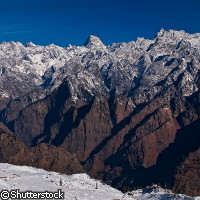HighNoon project tackles global water cycle dilemma
The HighNoon project, a collaboration between the EU and India, has got off the ground. Its primary objective is to evaluate the impact of the retreat of Himalayan glaciers and potential changes in the Indian summer monsoon on the distribution of water resources in northern India. Supported with EUR 3 million in funding, HighNoon is also seeking to provide recommendations for appropriate and effective response strategies to adapt to 'hydrological extreme events through a participatory process'. The HighNoon consortium, comprised of researchers from India, Japan, the Netherlands, Switzerland and the UK, is also working with researchers from the EU-funded WATCH project, which is assessing global interactions between water cycle, water resources and climate change for Europe and the Indian subcontinent. HighNoon is focusing on consolidating existing climate and hydrological data and innovative regional models. Ultimately, the project partners will combine the results of enhanced climate modelling in order to estimate practical and applicable adaptation measures. From now until 2012, the HighNoon consortium is using improved regional climate simulations to set up snowmelt and monsoon patterns, and regional models to develop realistic regional socioeconomic scenarios and evaluate water resources. The project is also offering new methods for prioritisation of adaptation measures that can be used as a design tool when choosing adaptation alternatives, particularly for land resources, water resources and food productivity. HighNoon will not only identify and quantify issues impacting the changing water availability in northern India, but it will also provide key actors (policy makers, water users and managers) with strategies that will help them deal with existing and future water-related problems. The global water cycle, which is a key component of the Earth system, is impacted by rising levels of carbon dioxide and temperature, which in turn raise the levels of rainfall, runoff and evapotranspiration (the sum of evaporation and plant transpiration from the Earth's land surface to the atmosphere). Experts predict that the Mediterranean region will observe a decrease in rainfall in future, while the Indian region will see an increase. Also, seasonality (when the data experiences regular and predictable changes that recur every calendar year) could also change, thereby triggering new and unanticipated vulnerabilities. Water cycle changes could bring on more extreme events like droughts and floods, which in turn could have a detrimental impact on agriculture. The impact would be felt in northern India, for example, where the water system is based on the monsoon precipitation in summer and the growth and melting of snow and ice cover in the Himalayas. HighNoon is the result of continuous dialogue and communication with researchers in India, initially initiated in 2007 at the First EU-India Strategic Workshop on 'Climate Change Research Needs'. '(The) EU and India enjoy strategic cooperation in the field of science and technology, with co-investment of resources from both players,' said H. E. Daniele Smadja, the European Commission's Ambassador to India. 'This current project in the field of climate change, research and glaciology takes this well-established partnership to new heights.'
Countries
India



